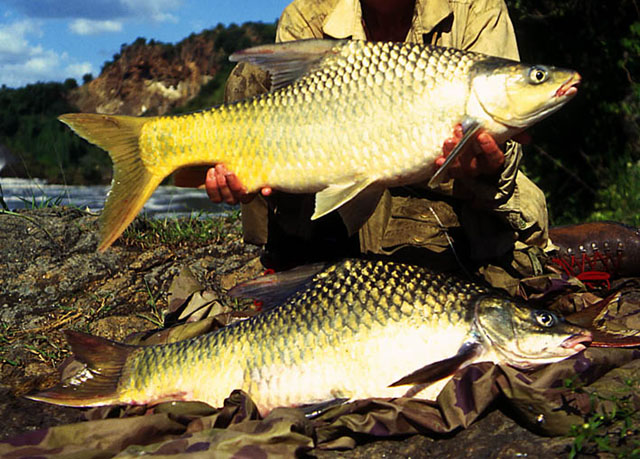| Cyprinidae (Minnows or carps), subfamily: Torinae |
| 82 cm TL (male/unsexed) |
|
benthopelagic; freshwater |
| Africa: Nile River and lakes once connected to the Nile system (Ref. 2801, 2959); Chad, Niger, Senegal, Volta, Ouémé and Ogun river basins (Ref. 2940, 81282); coastal rivers (Sassandra, Bandama, Niouniourou, Comoé and Tano) of Côte d'Ivoire and Ghana, west of the Volta basin. Following subspecies are recognized: Labeobarbus bynni bynni; Labeobarbus bynni occidentalis and Labeobarbus bynni waldroni. |
|
Anal soft rays: 8-8. Diagnosis: last simple dorsal-fin ray forming ossified spine longer than head in specimens over 150 mm SL; scale formula 5.5/26-31/4.5-5.5; 2.5-3 scales between lateral line and middle of belly, behind pelvic-fin origin; 12 scales around caudal peduncle; dorsal fin with 4 unbrached and 9 branched rays; anal fin with 3 unbranched and 5 branched rays; pectoral fin with 16-19 rays; pelvic fin with 1 unbranched and 8 branched rays; 3-5/12-15 gill rakers on first gill arch (Ref. 2940, 81282).
Description: large species, body rather deep in adults and slightly compressed; lips well developed, forming rounded mental disk; last simple dorsal-fin ray forms thick spine in adults; spine grows, being shorter than head in juveniles and longer than head in specimes over 150 mm SL; longest dorsal-fin ray is first branched ray; distal margin of dorsal fin slightly concave (Ref. 2940, 81282).
Coloration: in life: sides yellowish tinged with orange, back greyish; fins more or less bright yellow except for caudal fin, which is orange in juveniles and medium-sized adults, and greyish in older fish; distal margins of dorsal and caudal fins black-edged (Ref. 2940, 81282). Preserved specimens: brownish (Ref. 2940, 81282). |
| Feed on crustaceans, insects, molluscs and organic debris; in the Jebel Aulia Reservoir, annual spawning coincides with the onset of the floods; fecundity estimates ranged from 72 x 1,000 at 33 cm (4 yrs.) to over 14 x 10,000 at 74 cm (8 yrs) (Ref. 28714). |
|
Least Concern (LC); Date assessed: 31 March 2021 Ref. (130435)
|
| harmless |
Source and more info: www.fishbase.org. For personal, classroom, and other internal use only. Not for publication.
